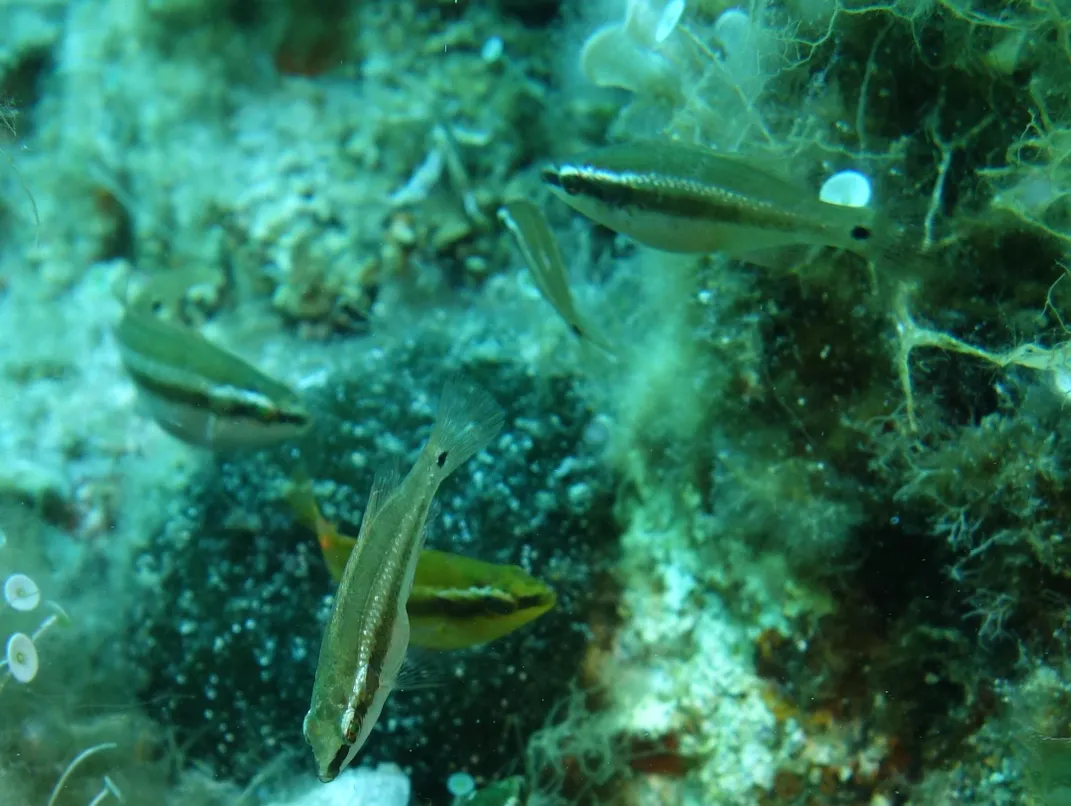Give it Up, Sneaky Males: These Lady Fish Have You Outwitted
Female ocellated wrasses have developed a surprising trick to control who fathers their offspring
/https://tf-cmsv2-smithsonianmag-media.s3.amazonaws.com/filer/8b/e6/8be6a59f-bf8f-4035-be28-3c9084452b89/wrasse_2.jpg)
Female ocellated wrasses—small, iridescent fish that swim in the Mediterranean Sea—don’t mate with just anyone. Call them old-fashioned, but they’re on the lookout for older, more attractive males who are interested in building algae nests and committing to sticking around to care for the couple's eggs. Once these choosy ladies have found their Prince Charming, females deposit their eggs on the conjugal algal bed, where their man will fertilize them externally.
That’s when this romantic story goes terribly awry. Oftentimes, this intimate scene will be interrupted by a sneaker male: a smaller, less fit fish with no intentions of staying to help out with the kids. Knowing that he doesn’t stand a chance of winning the girl, a sneaker instead swoop in and releases formidable clouds of semen all over her unfertilized nest—in a totally non-consensual attempt to father her kids with little to no effort. Rude.
For decades, biologists have thought of sneakers as an alternative evolutionary strategy for passing along one’s genes—one that succeeds often enough for it to persist into the next generation. But as it turns out, sneaker males largely do not get the last laugh. New research published today in Nature Communications reveals that females have a counter-strategy up their scaled sleeves: They surround their eggs with ovarian fluid, which ensures that faster sperm—which is typically produced by nesting males—gets the advantage.
“This was something we didn’t think was possible in the marine environment,” says Suzanne Alonzo, a marine scientist at the University of California at Santa Cruz, and lead author of the study. “That females influence the father of their young even after mating opens up a whole new world of possibilities for what females are doing, and for understanding how that affects which traits are evolving.”
In addition to being physically superior to sneaker males, nesting males boast better-quality sperm that's stronger and faster than that of their underhanded counterparts. To make up for this, sneaker males go for quantity over quality, releasing about four times as much sperm as their competitors. Yet according to the research, ovarian fluid seems to reduce the importance of sperm number.
To investigate the ovarian fluid effect, the researchers conducted sperm competitions in petri dishes containing unfertilized eggs. They pitted nesting and sneaker male gametes against one another in both the presence and absence of ovarian fluid, then performed genetic paternity analyses of the eggs to tally up the winners. Ovarian fluid seemed to enhance sperm’s existing qualities, giving the already-superior nesting male sperm a performance boost.

Researchers aren't sure what it is about ovarian fluid—which many species of fish release along with their eggs—that gives the upper hand to faster and more motile sperm. Future studies will have to ferret out the biochemical mechanism behind this trick. What's clear is that females are leveling the playing field, so that fertilization is no longer solely a numbers game. “It’s not 100 percent control,” Alonzo says. “But the majority, about two-thirds, are fathered by the nesting males.”
“The fact that this post-mating choice of preferred males is happening outside the female’s body is remarkable,” says John Fitzpatrick, a zoologist at Stockholm University in Sweden who was not involved in the research. “This is a really fantastic result that will certainly change the way we think about female control over reproduction.”
Our understanding of female mate choice has become more sophisticated over the years. Researchers originally thought that females could only exert their will over paternity before mating. Yet in the past two decades, scientists have found evidence that females of some species have developed innovative techniques for influencing which sperm fertilizes their eggs after mating.
For example, red flour beetle females sort different males’ sperm into distinct storage receptacles that they can choose to use at will; female rats can refuse to prepare their uterus for implantation after mating; and bleeding-heart monkeys can terminate pregnancies if a male they like better comes along. This new work on ocellated wrasses shows that females that use external fertilization are similarly adept when it comes to exerting influence which males sire the majority of their young.
Many fish species use external fertilization, as do other creatures such as frogs, crustaceans and squid. It could be that what we previously thought was impossible is actually commonplace. “We’d like to see whether we can find evidence that females can choose among males after external fertilization in other species that use similar mating systems,” Alonzo says. “I imagine all of these cryptic interactions going on that we don’t see, but that are very important to the patterns that we see among species.”
/https://tf-cmsv2-smithsonianmag-media.s3.amazonaws.com/accounts/headshot/Rachel-Nuwer-240.jpg)
/https://tf-cmsv2-smithsonianmag-media.s3.amazonaws.com/accounts/headshot/Rachel-Nuwer-240.jpg)